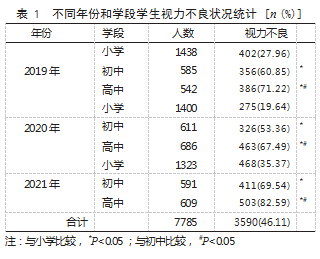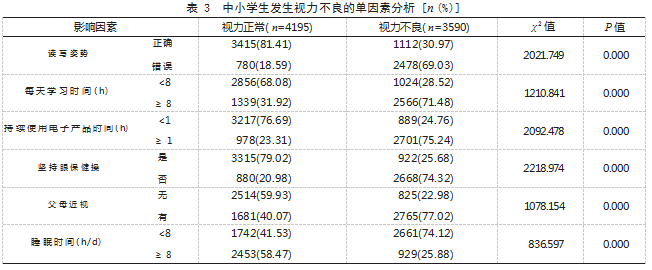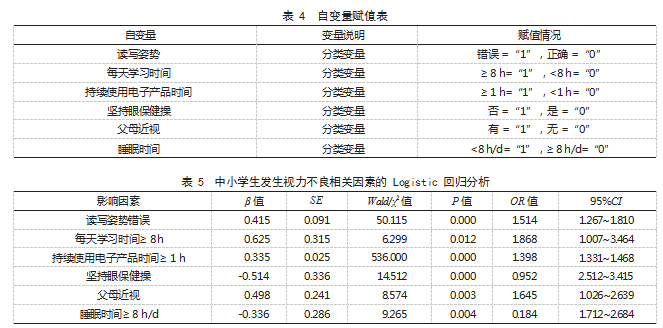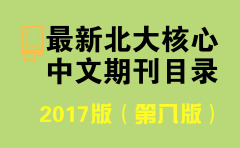永丰县2019—2021年中小学生视力不良状况及影响因素论文
2023-10-12 15:43:11 来源: 作者:hemenglin
摘要: 目的:调查分析永丰县 2019—2021 年中小学生视力不良状况及影响因素。方法: 选取 2019—2021 年永丰县 8 所中小学 7785 名体检者为研究对象
【摘要】 目的:调查分析永丰县 2019—2021 年中小学生视力不良状况及影响因素。方法: 选取 2019—2021 年永丰县 8 所中小学 7785 名体检者为研究对象, 均行双眼裸眼视力检查和电脑验光。统计中小学生视力不良发生情况和视力不良程度分级, 采用单因素分析与 多因素 Logistic 回归分析中小学生视力不良的影响因素。结果: 2019—2021 年, 永丰县中小学生视力不良发生率为 46.11%(3590/7785), 其中 2019 年视力不良发生率为 44.60%(1144/2565),2020 年视力不良发生率为 39.45%(1064/2697),2021 年视力不良发生率为 54.77%(1382/2523) ;同一年份不同学段视力不良发生率比较,高中 > 初中 > 小学,差异有统计学意义( P<0.05) ;各年份小学生轻度 视力不良占比均高于初中生和高中生,而重度视力不良占比均低于初中生和高中生,差异有统计学意义( P<0.05) ;视力不良者读写姿 势错误、每天学习时间≥ 8 h、持续使用电子产品时间≥ 1 h、父母近视占比均高于视力正常者,坚持眼保健操、睡眠时间≥ 8 h/d 占比均 低于视力正常者,差异有统计学意义( P<0.05) ; Logistic 回归分析结果显示,读写姿势错误、每天学习时间≥ 8 h、持续使用电子产品时 间≥ 1 h、父母近视均为影响中小学生发生视力不良的危险因素( OR>1. P<0.05) , 坚持眼保健操、睡眠时间≥ 8 h/d 为中小学生发生视 力不良的保护因素( OR<1. P<0.05)。 结论: 永丰县 2019—2021 年中小学生视力不良发生率较高,读写姿势错误、每天学习时间≥ 8 h、 持续使用电子产品时间≥ 1 h、父母近视均为影响中小学生发生视力不良的危险因素,坚持眼保健操、睡眠时间≥ 8 h/d 为中小学生发生视 力不良的保护因素。
【关键词】 中小学生,视力不良,近视,读写姿势,学习时间,影响因素
Poor vision status of primary and secondary school students in Yongfeng County from 2019 to 2021 and its influencing factors
LIU Hongyan
(Public Health Department of Yongfeng County Center for Disease Control and Prevention, Ji’an 331500 Jiangxi, China)
【Abstract】 Objective: To investigate poor vision status of primary and secondary school students in Yongfeng County from 2019 to 2021 and to analyze its influencing factors. Methods: A total of 7785 physical examinees from 8 primary and secondary schools in Yongfeng County from 2019 to 2021 were selected as the research objects. All subjects underwent binocular naked vision examination and computer optometry. The incidence of poor vision and the classification of poor vision in these primary and secondary school students were statistically analyzed. Univariate and multivariate logistic regression were used to analyze the influencing factors of poor vision in these primary and secondary school students. Results: The incidence of poor vision among the primary and secondary school students in Yongfeng County from 2019 to 2021 was 46. 11% (3590/7785), wherein the incidence rates of poor vision in 2019. 2020 and 2021 were 44.60% (1144/2565), 39.45% (1064/2697) and 54.77% (1382/2523), separately. The incidence of poor vision in different learning stages in the same year was statistically different (P<0.05), high school > junior high school > primary school. In each year, the proportion of mild poor vision in the primary school students was higher than that in the junior high school students and the senior high school students, while the proportion of severe poor vision was lower than that in junior high school students and senior high school students, and the differences were statistically significant (P<0.05). The proportions of reading and writing posture errors, daily learning time ≥ 8 h, continuous use of electronic products ≥ 1 h, and parental’ myopia in the students with poor vision were higher than those in those with normal vision; the proportions of adherence to eye exercises and sleep time ≥ 8 h/d was lower than those with normal vision; and the differences were statistically significant (P<0.05). Multivariate Logistic regression analysis showed that reading and writing posture errors, daily learning time ≥ 8 h, continuous use of electronic products ≥ 1 h, and parental myopia were all risk factors for poor vision in the primary and middle school students (OR > 1. P<0.05). Adherence to eye exercises and sleep time ≥ 8 h/d were all protective factors for poor vision in the primary and middle school students (OR<1. P<0.05). Conclusions: The incidence of poor vision among the primary and middle school students in Yongfeng County from 2019 to 2021 is high. Reading and writing posture errors, daily learning time ≥ 8 h, continuous use of electronic products ≥ 1 h, and parental myopia are the risk factors for poor vision in the primary and middle school students, while adherence to eye exercises and sleep time ≥ 8 h/d are the protective factors.
【Keywords】 Primary and secondary school students; Poor vision; Myopia; Reading and writing posture; Learning time; Influencing factor
随着智能手机的普及和各种电子游戏的推出, 加上课业繁重、户外活动减少,当前中小学生视力 不良发生率居高不下 [1-2] 。了解中小学生视力不良 状况及影响因素,有助于指导学生科学用眼,预防 视力不良的发生,或尽早予以视力矫正,防止近视 程度加深 [3-4]。本文了解并分析永丰县 2019—2021 年中小学生视力不良状况及影响因素。
1 资料与方法
1.1 一般资料 选取永丰县 2019—2021 年 8 所学 校 7785 名中小学生为调查对象,排除先天性白内 障、视网膜疾病。其中男 4221 名, 女 3564 名; 小 学生 4161 名,初中生 1787 名,高中生 1837 名; 年龄 8~18 岁,平均(12.41±1.56)岁。
1.2 方法 ( 1 )视力检查。行双眼裸眼视力检查 和电脑验光, 采用标准对数视力表检查裸眼视力, 其中单眼裸眼视力 4.9 表示轻度视力不良; 4.6~4.8 表示中度视力不良; ≤ 4.5 表示重度视力不良。(2) 收集基础资料。根据本县实际情况设计《中小学生 视力不良影响因素专项调查问卷》,由学生实名填 写,问卷包括学生读写姿势、每天学习时间、持续 使用电子产品时间、做眼保健操情况、父母近视情 况、睡眠时间等。本研究共发放问卷 7785 份, 回 收 7785 份,有效回收率为 100%。
1.3 观察指标 ( 1 )中小学生视力不良发生状况 和视力不良程度。(2) 中小学生发生视力不良的 单因素分析。(3) 中小学生发生视力不良的多因 素 Logistic 回归分析。
1.4 统计学方法 采用 SPSS 20.0 软件处理数据, 计数资料以率(%)表示,采用 χ2 检验,多因素分 析采用 Logistic 回归分析,以 P<0.05 为差异有统计 学意义。
2 结果
2.1 不同年份和学段学生视力不良情况 2019—2021 年,永丰县中小学生视力不良发生率为 46.11% (3590/7785) ,其中 2019 年视力不良发生 率为 44.60% (1144/2565), 2020 年视力不良发生 率为 39.45% (1064/2697), 2021 年视力不良发生 率为 54.77% (1382/2523) ; 同一年份不同学段视 力不良发生率比较,高中 > 初中 > 小学,差异有统 计学意义( P<0.05)。见表 1.

2.2 各年份不同学段学生视力不良程度比较 各 年份,小学生轻度视力不良占比均高于初中生和高 中生, 而重度视力不良占比均低于初中生和高中生,差异有统计学意义(P<0.05)。见表 2.

2.3 中小学生发生视力不良的单因素分析 视力 不良者读写姿势错误、每天学习时间≥ 8 h、持续 使用电子产品时间≥ 1 h、父母近视占比均高于视 力正常者,坚持眼保健操、睡眠时间≥ 8 h/d 占比 均低于视力正常者, 差异有统计学意义( P<0.05)。 见表 3.

2.4 中小学生发生视力不良的 Logistic 回归分 析 以中小学生发生视力不良为因变量(发生 =1. 未发生 =0) ,以读写姿势、每天学习时间、持续 使用电子产品时间、坚持眼保健操、父母近视情况、 睡眠时间作为自变量,赋值见表 4.Logistic 回归分 析结果显示,读写姿势错误、每天学习时间≥ 8 h、 持续使用电子产品时间 ≥ 1 h、父母近视均为影 响 中 小 学 生 发 生 视 力 不 良 的 危 险 因 素( OR>1. P<0.05) ,坚持眼保健操、睡眠时间 ≥ 8 h/d 均为 影响中小学生发生视力不良的保护因素( OR<1. P<0.05)。见表 5.

3 讨论
近年来,我国中小学生视力不良发生率居高不 下,已成为严重的公共卫生问题 [5] 。视力不良不仅 会阻碍学生身心健康发展,还对升学和未来就业造 成不同程度的影响 [6]。
本研究结果显示,永丰县 2019—2021 年中小 学生视力不良发生率为 46.11% (3590/7785); 单 因素与 Logistic 回归分析结果显示,读写姿势错误、 每天学习时间≥ 8 h、持续使用电子产品时间≥ 1h、 父母近视均为影响中小学生发生视力不良的危险因 素,坚持眼保健操、睡眠时间≥ 8 h/d 均为中小学 生发生视力不良的保护因素。分析原因为读写时眼 睛与课本的距离不足 30 cm、坐姿不端正等均可导致眼睛调节异常,易发生用眼疲劳,且低头会使颈 部血流受阻,眼压升高,增加儿童视力不良发生风 险 [7-8] 。每天学习时间≥ 8 h 和持续使用电子产品 时间≥ 1 h 均会减少眨眼次数,导致眼疲劳和视力不良, 严重者可出现眼压升高 [9]。近视具有遗传性, 父母一方近视, 子女近视风险会增高 10%~15%,若父母双方近视,子女近视率可达 30%[10-11] 。眼保 健操可改善眼部血液循环,缓解视疲劳,并预防近 视 [12] 。睡眠时间 ≥ 8 h/d、睡眠环境良好均有助于 缓解眼疲劳, 这是因为睡眠时眼部血液循环变缓, 眼调节肌逐渐放松 [13]。据此建议, 学校可通过讲座、 校园板报等方式加强用眼卫生宣传,督促学生纠正 错误读写姿势,缩短电子产品使用时间,坚持眼保 健操,保障睡眠时间,以减少中小学生视力不良的 发生。
综上所述,永丰县 2019—2021 年中小学生视 力不良发生率较高,读写姿势错误、每天学习时 间≥ 8 h、持续使用电子产品时间≥ 1h、父母近视 均为影响中小学生发生视力不良的危险因素,坚持 眼保健操、睡眠时间≥ 8 h/d 均为中小学生发生视 力不良的保护因素。
参考文献
[1] 徐渴,刘忠慧,冯宝佳,等 . 天津市 2018 年中小学生视力不良现状及影响因素分析 [J]. 中国慢性病预防与控制, 2021. 29 (8): 589-592.
[2] 侯丽明,张晓红,孟亚清,等 . 山西省 2019 年中小学生视力不良现状分析 [J]. 中国药物与临床, 2021. 21 (14): 2459- 2460.
[3] 刘念,何海艳,许云峰,等 . 绵阳市中小学生视力不良检出现状及影响因素分析 [J]. 预防医学情报杂志, 2020. 36(10): 1300-1302.
[4] 汪静,勉丽娜,韩霄 . 东城区中小学生重度视力不良的影响因素分析 [J]. 预防医学, 2021. 33 (2): 174-177.
[5] 李伟铭,郭秀花,宋玉珍,等 . 北京市中高考学生 2009-2018年视力不良现况与趋势 [J]. 中国学校卫生, 2020. 41 (9): 1292-1294.
[6] 陈剑宇,周亮,曾婕,等 . 四川省 2015 年中小学生视力不良现状与影响因素分析 [J]. 中国学校卫生, 2017. 38 (5): 773-775.
[7] 郝莉,朱冰,施文英,等 . 杭州市 2013 ─ 2017 学年中小学生视力不良现况分析及教学环境的关联作用 [J]. 中华眼视光 学与视觉科学杂志, 2020. 22 (8): 589-595.
[8] 杨仁东,肖伟华,徐晓敏 . 2020 年珠海市中小学生视力不良流行现状分析 [J]. 预防医学情报杂志, 2022. 38 (3): 342- 346.
[9] 朱剑妮 . 2019 年南宁市中小学生视力不良现状及其影响因素 [J]. 预防医学情报杂志, 2021. 37 (12): 1668-1673.
[10] 李凤娟,王丽茹,王旭,等 . 2018 年河南省中小学生视力状况和屈光状态分析 [J]. 现代预防医学, 2021. 48 (17): 3135-3137.
[11] 沈明辉,杨志群,吴中东,等 . 佛山市高明区中小学生视力健康影响因素调查 [J]. 职业与健康, 2020. 36 (5): 685- 688.
[12] 严蓓,龚雯娟,姚婷,等 . 2015—2018 年上海市某社区幼儿园及中小学生视力及屈光状态分析 [J]. 公共卫生与预防医学, 2020. 31 (2): 82-85.
[13] 唐斌,甘树发 . 2018 年重庆市江北区中小学生近视发生危险因素分析 [J]. 预防医学情报杂志, 2020. 36 (12): 1594- 1599.










